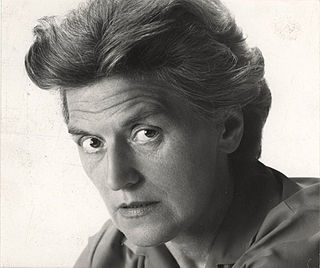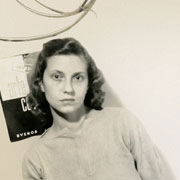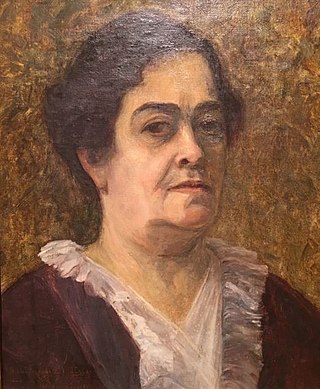
Altare is a comune (municipality) in the Province of Savona in the Italian region Liguria, located about 45 km (28 mi) west of Genoa and about 11 km (6.8 mi) northwest of Savona. As of 1 January 2009, it had a population of 2,160 and an area of 11.7 km2 (4.5 sq mi).

The Confitería del Molino is an historical Art Nouveau style confitería (coffeehouse) in Buenos Aires, Argentina, located in front of the Palace of the National Congress and the Congressional Plaza, on the intersection of Callao and Rivadavia avenues in the barrio of Balvanera.

Liliana Porter is an Argentine contemporary artist working in a wide variety of media, including photography, printmaking, painting, drawing, installation, video, theater, and public art.

Elda Cerrato was an Italian-born Argentine artist who was professor at the Universidad de Buenos Aires, and lifelong partner of composer Luis Zubillaga.

Annemarie Heinrich was a German-born naturalized Argentine photographer, who specialized in portraits and nude photographs. Heinrich is considered one of Argentina's most important photographers.

Adriana Lestido is an Argentine photographer. Her black-and-white photographs document the often difficult place of women in society.

Lidia "Lidy" Elena Prati (1921–2008) was an Argentine painter who was known for her abstract, geometric paintings. Her artwork called into question representational art and was influential in defining the concrete art movement in Latin America. Prati contributed to the publication of Arturo magazine and during the 1940s, was one of the founding members of the Asociación Arte Concreto-Invención (AACI) art movement along with Enio Iommi and Tomás Maldonado. While she is primarily known for her concrete art paintings, Prati also worked in graphic and layout design and worked with textiles and jewelry.

María Obligado de Soto y Calvo was an Argentine painter who worked in a variety of genres.

Martha Boto was an Argentine artist. Boto was born in Buenos Aires, Argentina, and was co-founder of the Group of Non-Figurative Artists of Argentina. She is considered to be a pioneer of kinetic and programmed art.
Víctor Luciano Rebuffo was an Italian-born printmaker, illustrator, and graphic novelist who lived and worked in Argentina.
Alicia D’Amico was an Argentine photographer. She was born in Buenos Aires, where her family had a photographic business. She ran a very productive studio with Sara Facio for twenty years. She published photography books and for the last twenty years of her life she focused on feminist issues and personal projects about the role of women in photography. She dedicated her entire life to photography, and she became a leading figure in Argentine photography.

Dalila Puzzovio is an Argentine visual artist and fashion designer active during the 1960s. Puzzovio works in the art forms of pop, happening, and conceptual art. Her artistic creativity is credited by Graciela Melgarejo as having paved the way for subsequent Argentine artists and greatly influenced the work they produced.
Eugenia Belín Sarmiento was an Argentinean painter and author. Her works were featured in various international shows, among them the first Exposición Anual de Pintura, Dibujo y Escultura for artists of South America in 1893. Critical response to her works has often focused attention on her portraits of her grandfather, Domingo Faustino Sarmiento, who was president of Argentina from 1868 to 1874. Eugenia completed many other works as well, including miniatures as well as full size portraits, paintings of flowers, birds, and still lives, and sculptures.

Julia Wernicke was an Argentine painter and engraver. She is known as the first animalist painter from Argentina and incorporated exotic animals into her paintings. She paved the way for female artists in Argentina through many firsts, especially within the discipline of engraving. Wernicke was one of the first women to have an individual exhibition of works in Buenos Aires, in 1897; and the first person to have an individual exhibition of engraved etchings in Argentina, in 1909.

Mónica Weiss is an Argentine illustrator, artist, writer and architect. She has illustrated more than 140 books and has actively worked for the rights of illustrators and to show the importance of illustration in Argentina.
Elizabeth Aro is an Argentine interdisciplinary artist from Buenos Aires. Aro uses fabric to create large-scale site-specific installations, and also uses photographs, drawings, and videos in her exhibitions. Many of her works relate to the perception of space and how individuals define home or where they are from.
Silvia Torras (1936–1970) was a Spanish-born Argentine informalist painter. Torras became a notable artist in the Argentine informalism movement and showed her work in several major exhibits during the short period she painted.
Matilde Marín is a contemporary Argentine artist who works in photography, engraving and video.
Silvia Rivas is an Argentine visual artist known for her multi-channel video installations. In Latin America she is considered a precursor in the area of expanded video. Her work is characterized by the crossing of materialities and technologies in which she uses both electronic devices and ancestral techniques. Her production is organized in thematic series of video installations, drawings, photographs or objects. Interested in revealing the metaphorical power of different materialities, she uses the electronic medium and the moving image to record stillness, the imminent and the subjective perception of time.
Natacha Voliakovsky is an Argentine queer Performance Artist and activist based in New York who develops part of her work in the field of bio-hardcore political performance, with the use of other media such as photography, video, and installation. She works by exposing and transforming her own body to the limit, with the aim of revealing through her high-impact performance, how those oppressive norms of the dominant culture operate. Through this proposal, she seeks to the question about the established moral and works on issues related to gender identity, the free sovereignty and autonomy of the body, the identity, the self-perception.












